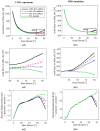Impact of Structural Compliance of a Six Degree of Freedom Joint Simulator on Virtual Ligament Force Calculation in Total Knee Endoprosthesis Testing
- PMID: 38672801
- PMCID: PMC11050787
- DOI: 10.3390/life14040531
Impact of Structural Compliance of a Six Degree of Freedom Joint Simulator on Virtual Ligament Force Calculation in Total Knee Endoprosthesis Testing
Abstract
The AMTI VIVO™ six degree of freedom joint simulator allows reproducible preclinical testing of joint endoprostheses under specific kinematic and loading conditions. When testing total knee endoprosthesis, the articulating femoral and tibial components are each mounted on an actuator with two and four degrees of freedom, respectively. To approximate realistic physiological conditions with respect to soft tissues, the joint simulator features an integrated virtual ligament model that calculates the restoring forces of the ligament apparatus to be applied by the actuators. During joint motion, the locations of the ligament insertion points are calculated depending on both actuators' coordinates. In the present study, we demonstrate that unintended elastic deformations of the actuators due to the specifically high contact forces in the artificial knee joint have a considerable impact on the calculated ligament forces. This study aims to investigate the effect of this structural compliance on experimental results. While the built-in algorithm for calculating the ligament forces cannot be altered by the user, a reduction of the ligament force deviations due to the elastic deformations could be achieved by preloading the articulating implant components in the reference configuration. As a proof of concept, a knee flexion motion with varying ligament conditions was simulated on the VIVO simulator and compared to data derived from a musculoskeletal multibody model of a total knee endoprosthesis.
Keywords: biomechanics; joint simulator; knee joint dynamics; multibody model; structural compliance; total knee endoprostheses.
Conflict of interest statement
The authors declare no conflict of interest.
Figures










References
-
- Zilles K., Tillmann B. Anatomie: Mit 121 Tabellen. Springer; Berlin/Heidelberg, Germany: 2010.
-
- Głowiński S., Krzyżyński T. An inverse kinematic algorithm for the human leg. J. Theor. Appl. Mech. 2016;54:53–61. doi: 10.15632/jtam-pl.54.1.53. - DOI
-
- Kebbach M. Computerbasierte Dynamische Funktionsanalyse des Endoprothetisch Versorgten Humanen Kniegelenks Mittels Muskuloskelettaler Mehrkörpersimulation. Dr. Hut; München, Germany: 2023.
Grants and funding
LinkOut - more resources
Full Text Sources
Research Materials

